
Model of a seacil
Yesterday, I attended a very illuminating and fascinating discussion about the controversial seacil project. It has brought a conclusion to a topic that has weighed heavily on the minds of many who have come to love our shores and the amazing diversity of marine life we still possess, and also spurred some debate over how we should protect and conserve our often fragile habitats.
For those who are puzzled as to what a seacil is, here's some background information...
Fragile Labrador
Labrador Park is one of 4 places gazetted as nature reserves, the highest possible level of protection any nature area can attain in Singapore. As it is the only nature reserve which protects one of the last stretches of natural rocky shore, seagrass meadow, and coral reef on mainland Singapore, it is a site that is very dear to many of us who explore Singapore's shores and waters. (On the other hand, this post raises a very important question as to whether the shore at Labrador Park is truly protected as part of a nature reserve or not)

Rocky shore and cliffs at Labrador;
(Photo by Ria; Most of the photos in this post are hers, unless otherwise stated)
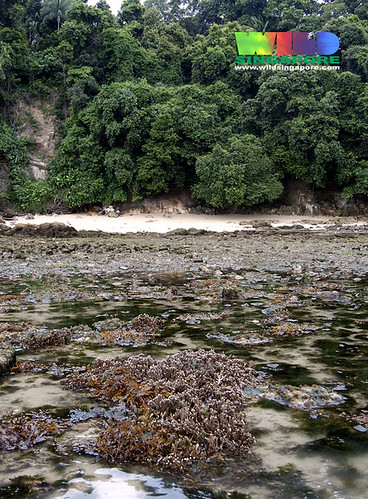
Live corals in the intertidal zone at Labrador;
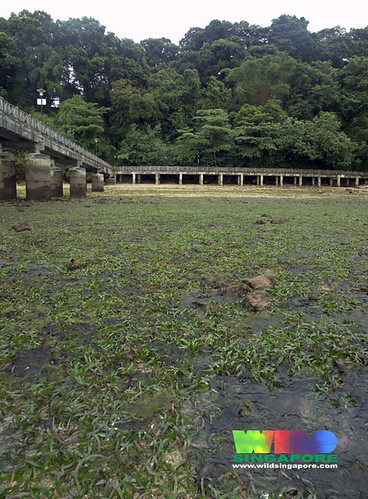
Labrador also has an extensive meadow of sickle seagrass (Thalassia hemprichii), one of the last remaining patches of this species on mainland Singapore;
Over the years, many generations of students and undergrads have visited the shores of Labrador, as it provides an excellent place to introduce students to the fact that Singapore does still contain a wonderful diversity of marine life.
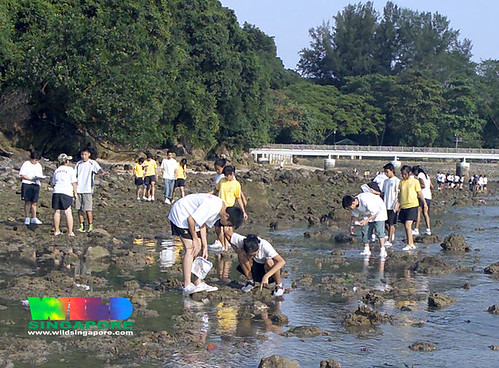
Living classroom on Labrador shore;

A book about the marine life of Labrador was also published in 1994.
Labrador is situated in quite a precarious location; for example, it is right next to the container terminal at Pasir Panjang, built by the Port of Singapore Authority (PSA). On the other side, there are residential and commercial developments and maritime facilities in Harbourfront and Keppel Bay. Work on tourism attractions on Sentosa is a short distance across the sea, and the oil refineries and chemical manufacturing plants of Pulau Bukom are just slightly farther away. Indeed, one of Labrador's unique points is that the shore is so rich in marine life despite being surrounded by so much development, shipping, and industries.
A lot of construction and other work in the surrounding areas began in July 2006, as part of the expansion of Pasir Panjang Terminal. For instance, besides extensive dredging in the seas nearby, a cofferdam was built as part of work to divert submarine services between Pasir Panjang and Pulau Bukom, in preparation for land reclamation next to Labrador.
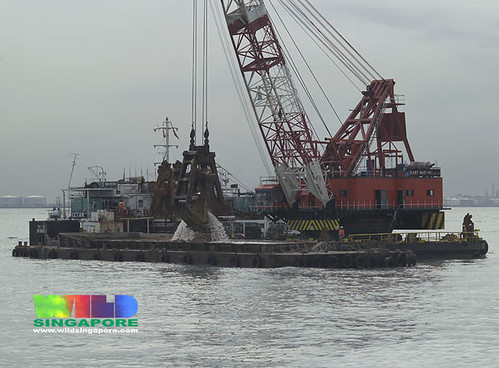
Dredging off Labrador, December 2006;
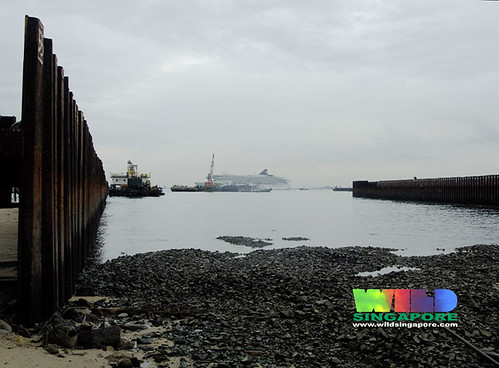
Huge cofferdam built at Labrador, December 2007;
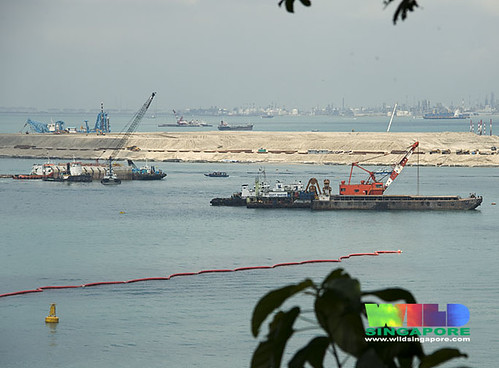
Reclamation for expansion of Pasir Panjang Terminal, March 2011;
There were concerns about the possible impact on the marine life at Labrador; a Biodiversity Impact Assessment Report (BIA) and an Environmental Impact Statement (EIS) had been prepared. A volunteer effort to relocate corals from areas that would be destroyed by the construction was also carried out in June 2006, before construction of the cofferdam commenced. Some studies have been done, which indicate that the marine life of Labrador has been negatively affected by the work nearby. In any case, many continued to visit and document the natural treasures that could be found on that stretch of seashore.
The nearby development seemed to bring with it a great deal more trash to Labrador, much of which seemed to have been deliberately dumped on the shore.
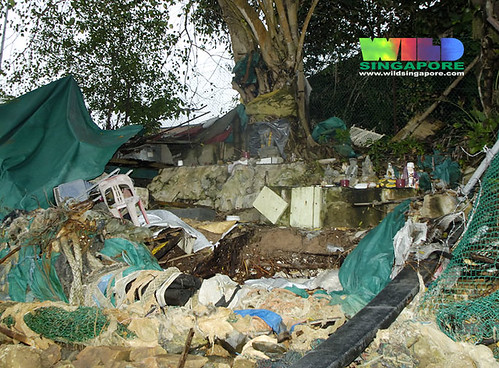
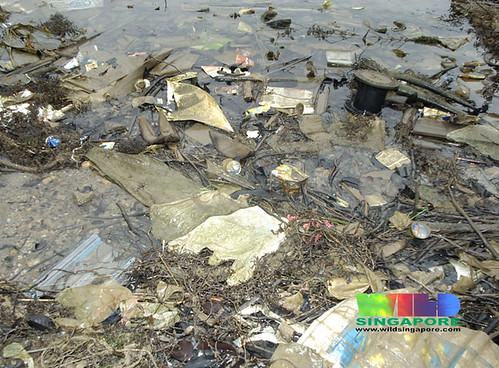
The Seacil Project
To exacerbate matters, even before construction commenced, visitors to the shore noticed a number of large objects placed on the shore, apparently as part of an experiment being conducted there.
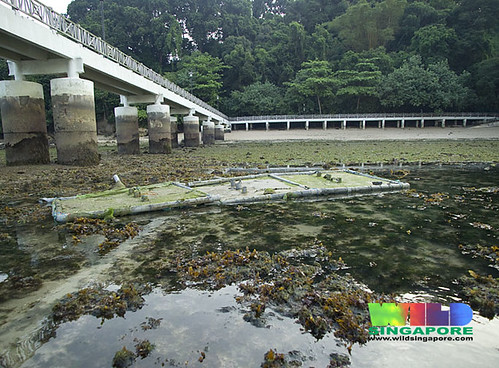
May 2006;

June 2006;
Over time, the structures appeared to be disintegrating, leaving PVC pipes and concrete slabs on the shore. Some of the smaller pieces were tossed about by the waves, rolling about and crushing fragile corals and seagrasses.
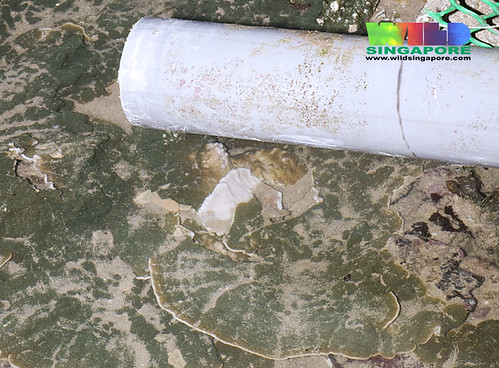
June 2006;
In late 2007, Ria Tan put two and two together when an article in the Straits Times reported about the seacil project, which had been taking place just offshore during this period of time.
Basically, the seacil is the centrepiece of an artificial reef project by the Singapore Maritime Academy at Singapore Polytechnic, led by manager Captain Frederick Francis. The brainchild of marine consultant Charles Rowe, it refers to structures built out of concrete and PVC pipes, which are then installed in deeper waters to allow organisms such as corals and sponges to colonise and enrich the local marine biodiversity. Corals which are threatened by development can also be saved by being relocated and grafted onto the seacil, where they may continue to survive and propagate.

Click on the scanned article to zoom in;
Involving 68 staff, students, volunteers, and divers, seacils were first installed at Sentosa, near the Riverboat. After that initial success, the project was then extended to Labrador Beach, where corals that would have been smothered and killed by the dredging and construction of the cofferdam were transplanted onto seacils placed in the sea, close to Labrador Jetty. Here is an article from Innovation Magazine, as well as a Powerpoint slide done by Singapore Polytechnic.

Click to enlarge;
All in all, it seemed like a fascinating project with noble aims, especially what with all the threats facing Singapore's coral reefs. Destruction due to coastal development and death of corals due to accumulation of silt and sediments are certainly among the greatest threats that our reefs face, and Singapore has explored various means of relocating corals from coasts slated for development.
However, from another perspective, there were criticisms about the way the project had been executed, in particular the construction of the structures on the shore. That some of the objects appeared to have fallen apart and were seen as continuing to damage the intertidal zone (as well as creating an eyesore) seemed at odds with the rosy picture of rescuing corals and creation of an undersea garden.
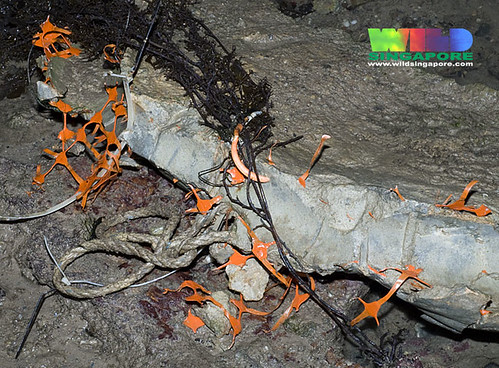
December 2007;
A number of bloggers shared their thoughts online, and it created quite a stir, which was reported in the press.
Here are some blog posts that have covered the apparent decline of Labrador. I think the general sentiment is that Labrador is deteriorating, likely as a result of the ongoing development just next to it, which was heartbreaking. That a project attempting to encourage artificial reefs offshore was inadvertently damaging seagrasses and corals in the process definitely did not help matters.
Wildfilms: Updates on large concrete slabs on Labrador shore
Labrador Nature Reserve: Trashed?
Singapore port expansion: impact on Labrador Nature Reserve?
Can Labrador survive?
Labrador Nature Reserve: after the construction
Justin Dive Adventures: Labrador Park seashore environment... with CONCRETE?!?
Is the Labrador talk really that cheap?
Labrador speaks a thousand words...
Labrador Episode 4: A New Hope
RedDotBeachBum: Labrador - hope & rebirth..... and waiting
The Annotated Budak: The sad state of Labrador
God's Wonderful Creation: Current state of Labrador Park
There were opportunities for dialogue and further discussion, but for some reason, on the part of the people behind the seacil project, it seemed like not much was being done to reach out to the people who had raised criticisms. After some correspondence with Ria via email, the organisers apparently just stopped responding to queries. It is true that many of us did not have the full picture, but it was a golden opportunity to come forward and provide further details about the project, hence filling in the gaps in our knowledge.
To their credit, some of the larger slabs on the shore were removed, and much of the other trash from the reclamation works nearby were cleared as well. In the meantime, some smaller pieces remained on the shore, and given that they were too heavy for us to haul out, and had since become well encrusted with marine organisms, we decided to leave them in place.
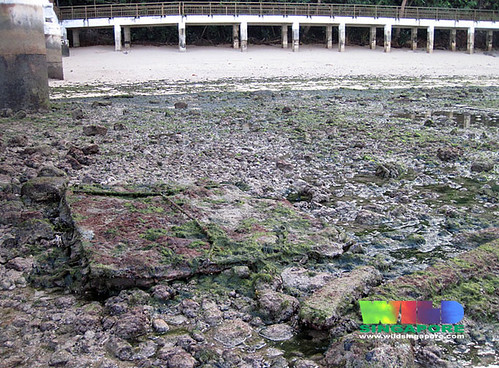
June 2008;
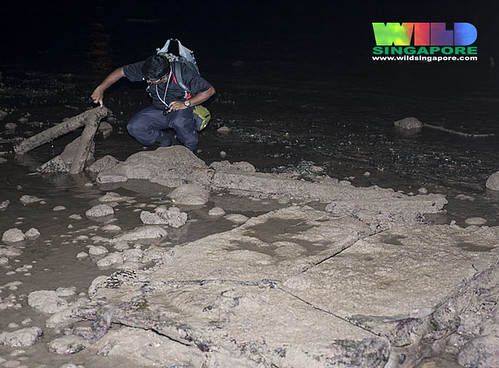
July 2011;
We did continue to take notice of these chunks on subsequent visits to the shore, but for the most part, we were under the impression that this was the end to our inquiries about the seacil project. Some of us continued to post images of what we thought could be remnants from the project, but more for the sake of documentation. We assumed that the project was still carrying out monitoring of the seacils already in place offshore, and that the people involved were not interested in speaking to us at all. To be honest, despite the initial clash, I think most of us were wishing that the seacils were truly serving their intended purpose and providing a useful substrate for corals to flourish and grow.
Discussion Time
Hence, it was quite surprising when we suddenly learnt that there was going to be a discussion about the seacil project, hosted by Nature Society (Singapore).
We weren't quite sure what to expect, and many of us in attendance yesterday night were not here to pick a fight, but rather, to seek further clarification and explanations, and to get answers to questions that we had been asking for years without success. I for one went in with an open mind, wanting to find out more, and genuinely hoping that the project had been a resounding success.
True to my reputation as a social media addict, I provided my usual service of live-tweeting the discussion as it unfolded. Here, in chronological order, are my tweets, as well as those of others in attendance. I wasn't able to note down some of the information that was presented quickly enough, but I believe I have most of the important points. For the moment, you can look through the whole record of tweets using the Twitter hashtag #seacil. You can also view photos of the Powerpoint slides and more details about the discussion over at Ria's post.
- Charles Rowe begins the #seacil discussion with video footage of a seacil off Labrador Park.
- The corals grafted onto the #seacil were from areas that would have been destroyed by construction of the coffer dam.
- Video footage was of #seacil 2 months after installation.
- Despite the poor visibility and large quantities of silt, there is new coral growth on the #seacil. Looks like zebra coral (Oulastrea crispata) to me.
- There is an observation platform on the front of the #seacil
- There is a plaque dedicating the #seacil to the memory of Charles Rowe's departed parents and sister.
- With use of concrete as basic material for the structure that would complement the underwater environment. #seacil
- Images of the corals that have been 'rescued' from areas that would have been reclaimed, and then grafted onto the #seacil
- Purpose of the #seacil - serves as cost-effective artificial reef that meets the International Maritime Organisation OSPAR Accord '99 (The International Marine Organisation and the OSPAR Commission are 2 entirely separate groups; I'm not sure which exact document is being referred to, but the Agreement of Cooperation between IMO and OSPAR is the only one I could find from 1999 which involves both groups. You can also take a look at OSPAR Guidelines on Artificial Reefs in relation to Living Marine Resources)
- Creates habitats for marine life, a means of disposing waste materials (e.g. concrete aggregates, fly ash), creates job opportunities #seacil
- Creates anchoring points for small crafts, esp. used for scuba tours, to offset damage created by dropping & lodging of anchors #seacil
- Creation of jobs, from fabricating & diving to position #seacil, to grafting marine life & monitoring, creating live rock #seacil
- To serve as a base for creating & cultivating live rock for the marine aquarium industry; #seacil
- Establishing subsea oasis for the release of food to encourage aggregation of marine life #seacil
- Charles Rowe covers the chronological sequence of events; involves the funeral of his mother, training deaf to work underwater #seacil
- In March 2000, small concrete test pieces using a mixture of beach sand, seawater and cement were made, placed at Pasir Ris #seacil
- The #seacil are made in situ on the beach, then moved to deeper water.
- 1st #seacil prototype was launched at Singapore Polytechnic Marina.
- Prior to phase 2, SP promoted establishment of underwater training with a #seacil PVC pipe frame, with the deaf being trained.
- In addition to Sentosa, MPA requested that the #seacil project could be applied at Labrador Park.
- In the Brani sea channel, test plates were inserted into the sea to experiment on success of grafting of marine life. #seacil
- 4 #seacil were planted at Sentosa, at the Riverboat area.
- And now we get a video montage, with footage from the news, showing the #seacil installation procedure at Sentosa, and photos of marine life found colonising a piece of the seacil.
- At Sentosa, the #seacil was colonised by soft corals; anemonefish were brought in and released. And there were strobe lights installed.
- The #seacil at Sentosa were lost due to further development for the Integrated Resort.
- NParks supported the #seacil project by allocating a site for experimentation. They were installed in the sea along the Labrador Jetty.
- Discussions were raised on means of rescuing corals that were threatened by placement of a subsea cable between Labrador & Bukom #seacil
- #Seacil were assembled on site at the shore of Labrador shore
- Charles Rowe claims that the shore on Labrador was lifeless; Ria disagrees, mentioning that there is a bed of Thalassia. #seacil (The sickle seagrass is locally Critically Endangered, and Labrador has the only good patch left on the mainland)
- Do we have to make a judgment call? Was it necessary to sacrifice the seagrass beds to rescue the corals? #seacil
- More than 800 corals were translocated onto 34 #seacil within a 2-week period, involving 56 volunteers.
- A cost-effective & efficient adhesive was created to attach the grafted corals onto the #seacil
- Images of grafted corals (sponges? fanworms?) on #seacil taken in Dec '10, Jan '11
- Construction of the coffer dam and subsea cable turned the water black, causing mortality of corals. #seacil
- Due to excavation, the sea turned black, and 40% of corals grafted on the #seacil died.
- A #seacil was made and installed in the Caspian Sea in Kazakhstan, with sturgeon fry being seen subsequently.
- I disagree that the shore on Labrador can be classified as "ooze and slime". I don't think it's less ecologically vaulable. #seacil
- Charles Rowe said the Straits Times chose not to publish his side of the story, focusing on the negative aspects. #seacil
- Another new #seacil was in the process of fabrication, but was removed due to a complaint from a member of the public.
- The speaker seems to be getting angry at his 'critics', knowing that many in the audience have raised criticism of his project. #seacil
- *snarky* #seacil required a lot of $, time & manpower to create a 'subsea garden'... Tanah Merah has an even nicer coral reef growing on an artificial seawall, and it all grew for free.
- RT @leafmonkey: I sense tons of anger from the speaker at the audience and I seriously doubt that he is willing to listen to us. #seacil
- More photos showcasing how well the corals have been growing on the #seacil
- A member of the audience asks if the #seacil could be used as a breakwater.
- Another possible use of a #seacil as a sensor, to detect shockwaves from dynamite fishing.
- 1-inch diameter hemp ropes were attached to the #seacil as an experiment for the growth of shellfish, such as mussels.
- 2 of the initial #seacil were connected by a 2 metre long mesh. Purpose of the mesh would be to introduce filter-feeders to remove sediments
- RT @leafmonkey feel like sitting duck in a talk where the speaker is continuously lambasting his audience comprised of people who did not commit the crime #seacil
- RT @leafmonkey he thinks that no Singaporeans are doing anything to save the corals. Instead we're stopping him from putting his own money to saving them #seacil
- @ikepod: @VaranusSalvator thanks for the updates on the #seacil debacle. Sounds tense!
- @ikepod It is! We're being very polite and letting him talk all about his project, but he seems quite upset about the criticism. #seacil
- Another possible use of the #seacil concept: heavy duty sub-sea pillboxes to stop and wreck trawling sleds, protecting the seabed.
- RT @leafmonkey Wow vigilante uses for the #seacil include militant uses against illegal fish trawlers as underwater deterrents. Creative!
- Q & A time! I hope things don't get too ugly. For what it's worth, Ria is a force of a nature and cannot be messed with. #seacil
- Local diving community was not engaged in subsequent monitoring of the #seacil
- 42 #seacil are still at Labrador.
- Some of the PVC pipes found on the shore were part of the #seacil project, but not incorporated into the #seacil themselves.
- Diplomatic efforts by @leafmonkey to try to explain the rationale behind some of the criticisms. #seacil
- Graduate student from NUS gives a blunt assessment and commentary on the #seacil project, in terms of costs & ecological collateral damage.
- Charles Rowe concedes that it's a missed opportunity that marine biologists were not intimately involved in the #seacil project.
- IMHO, the #seacil project had a lot of potential, but a lot of problems arose due to lack of involvement of marine biologists.
- Ria's turn to speak. This might get interesting. #seacil
- Ria shares about marine life that colonised artificial shores. Including the pontoons at Keppel Marina & seawall at Tanah Merah. #seacil
- Ria mentions how important it is to have open discussions early on to avoid a lot of the negative sentiments surrounding the #seacil
- Charles Rowe agrees with a lot of Ria's points, but feels that the ends (collateral damage to other habitats) justify the means. #seacil
- And the discussion of the #seacil project comes to an end. It's been a most illuminating time.
- Model of the #seacil http://twitpic.com/5wobjf
- One point I've learnt after the #seacil discussion: people need to know the difference between seaweeds and seagrasses.
- RT @koksheng @VaranusSalvator Thanks Ivan for your tweets... Though I can't be there as am tight with work, at least I knew roughly what's going on
- RT @jehkay Was there a productive outcome to the #seacil discussion?
- @jehkay Yeah I'd say so. I think at this point in time, there are no plans to continue making and installing more #seacil.
- RT @micamonkey I learnt today that no matter how small you think the community is, there are always other like-minded groups you don't know of yet #seacil
During his presentation, one could see Charles Rowe's dedication and passion for this so-called pet project. He rendered many of his services and expertise for free, contributing financially, being personally involved in the physical effort of the creation and installation of the Seacils despite his age, and even incurring an injury that put him in hospital for 5 days. And considering that the final Seacil which was placed at Labrador bears a plaque dedicated to his dearly departed family members, you can see how this effort has truly been a labour of love for him, borne out of a singular passion to push through an idea and make it a reality.
Thoughts After the Discussion
To be honest, I think the seacil is an idea that holds great potential for coral reef restoration, especially in areas where the original hard coral growth has deteriorated or become degraded due to excessive sedimentation or coral bleaching, or destructive practices such as dynamite and cyanide fishing, or harvesting of corals for souvenirs and the aquarium industry. I do think that there are a lot of possibilities that can be explored.

Coral reef destroyed by dynamite fishing, Similan;
(Photo by alpine diver)
But the main reason why many of us had been unhappy about this project was in the implementation; it is true that on-site construction in the form of building the frames and concrete slabs on the beach helped to save manufacturing costs, but was it worth the potential damage to the seagrasses and corals in the intertidal zone? Charles Rowe had the impression that damaging some areas of seagrass in the process of construction of the seacils was acceptable in light of saving corals. I personally feel that we do not need to make such a value judgment. Yes, everybody likes coral reefs and wants to see colorful corals, with pretty fishes swimming amongst them. But seagrasses also constitute important habitats for a multitude of marine organisms, and they too have been severely affected on a global scale by pollution and coastal development.

Seagrass meadows on Cyrene;
It's a lot like how a study commissioned by the Housing Board initially stated that Chek Jawa lacked an established coral reef, nor did it have a resident population of dugongs (with seagrass being 'patchy and not abundant'), hence implying that it was not ecologically valuable and was worth sacrificing for the greater good of national development.
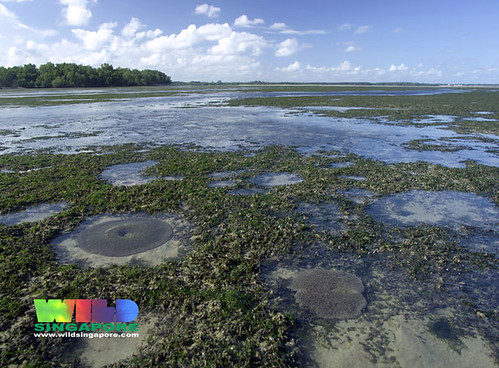
Seagrass lagoon at Chek Jawa;
Such thinking reflects a fundamental ignorance of how the natural world works. It is easy to consider each habitat as a distinct little world unto itself; indeed, many species are found exclusively in a particular biotope, and such simplified classifications allow us to get a handle on the health of these habitats, and any changes in area. Yet reality is a lot more complicated. One does not find discrete borders between 2 habitats, and each ecosystem does not exist in a vacuum, completely cut off and isolated from surrounding habitats. You find that many species often move between habitats, and that nutrients from one habitat often end up sustaining and feeding organisms in another. Ultimately, every ecosystem is connected in an intricate web of relationships that ultimately span the globe, constituting the entire biosphere.

Seagrass meadows and coral reefs on Cyrene;
To plant artificial reefs to promote coral growth, while ignoring the impact on nearby currently existing habitats, is to overlook the importance of these other communities. Classifying such non-reef habitats as 'ooze' and 'slime', and to insinuate that the seabed was formerly lifeless before seacils were installed, reveal a deep-seated bias and lack of appreciation for the fact that there is more to marine conservation than just coral reefs. Yes, seagrasses may regrow, but it is a slow process that takes time, and it doesn't change the fact that an important population of a Critically Endangered species was put at risk.
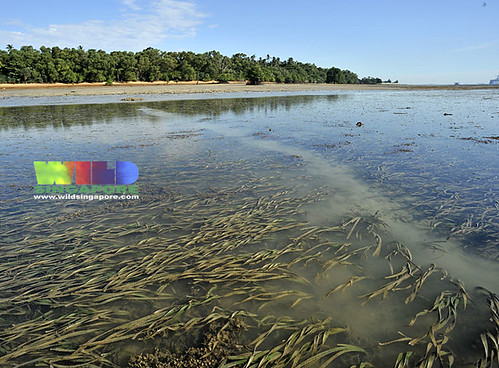
For example, on Pulau Semakau, the feet of countless visitors have created a clear path through the seagrass over the years. Seagrasses are simply not as prolific and as hardy as many seaweeds.
Note that I'm not against the seacil project itself; the idea is definitely worth exploring further in other contexts, and it does at least provide a suitable subtrate for corals and other sessile organisms to colonise and grow. Because of the development work that has gone on adjacent to the park, the waters aren't exactly the most conducive for coral growth to begin with, so it is heartening to see that some corals have managed to get a foothold and survive (although to be honest, some species are very resilient and will apparently grow in pretty bad conditions). Perhaps, given enough time and lack of further disturbance after construction work is finally completed, the muck will settle, the area will recover, and corals will truly flourish on the seacils.
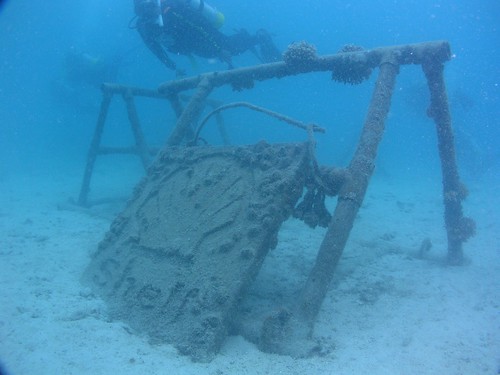
Artificial reef, Perhentian;
(Photo by Sharkyjones)
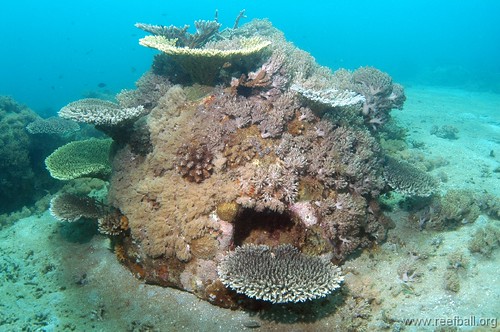
Coral growth on artificial reef;
(Photo by reeftodd)
The intentions behind the project are good, and one cannot fault Charles Rowe's passion and dedication. I believe the general sentiment is that the concept is impressive and definitely created with good intentions, but we cannot afford to sacrifice the seagrasses and corals in the intertidal zone that have been growing naturally all along, simply for the sake of encouraging artificial reefs. As far as marine conservation is concerned, we don't quite see it such that one particular habitat has to be encouraged at the expense of another.
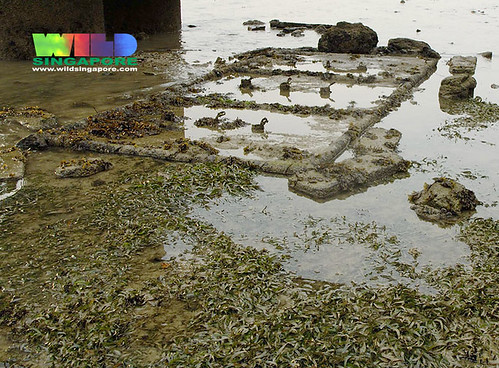
November 2007;
That professional marine biologists or other people well-versed with marine life were not involved is another flaw in the project, one that I find jeopardises the entire value of the project. To be honest, I am puzzled as to why there was no marine biologist on board, at least to help with species identification, such as differentiating seaweeds from seagrasses (no, the terms are not interchangeable). For any project which aims to restore degraded habitat, one needs scientists who are able to devise a proper framework for research, and to evaluate the success of the project based on the growth of marine life, even if it's merely on a consultation basis. It's not enough to simply show photos of corals on the seacil, one needs to have a comprehensive survey to document key information, so as to provide conclusive evidence that the structures have indeed provided an overall benefit to the survival and growth of corals. Here is a list of key information that I would be looking out for if I was involved in an artificial reef project:
- Baseline data on the extent of coral growth on the seabed before the structures are installed
- What sort of organisms are growing on the structures? (It's not enough to just list down 'seaweed', 'soft coral', 'hard coral', 'sponge' etc., but to narrow it down ideally to genus or even better, species)
- To what extent is coral cover resulting from natural recruitment? What is the growth rate of these corals?
- Out of all the corals that were rescued and grafted onto the structures, what are the survival and growth rates? (This point was rendered moot when pollution from the development works killed off approximately 40% of the corals on the seacils)
- How does the growth rate of the corals on the structures (whether grafted or natural recruitment) compare to that of corals growing on artificial and natural reefs elsewhere in Singapore?
Obviously, collecting such data requires a lot of time spent underwater carrying out rigorous surveys, necessitating the commitment of a team of trained individuals carrying out dives at regular intervals to check on the progress. Which is why I raised my hand at one point and asked whether divers from other coral monitoring efforts such as ReefFriends had been approached to assist in assessing coral growth on the seacils, which was not the case.
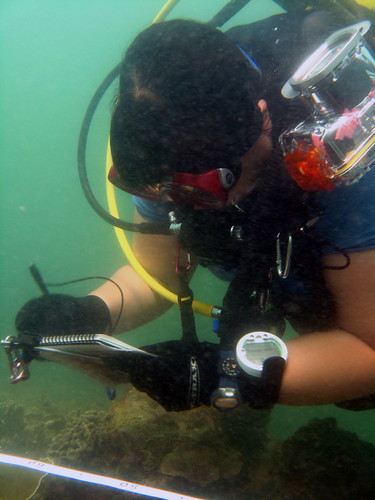
ReefFriends survey at Raffles Lighthouse;
(Photo by Orang Asli)
Proclaiming that the project was a resounding success because some corals are now growing on the seacil, when there were none on the mucky seabed, does not necessarily make it so.
Ria shared about how marine life is able to settle naturally on artificial structures; the pontoons at Keppel Marina and Seringat-Kias are covered in a profusion of corals, and a beautiful coral reef now grows on the seawall along Tanah Merah.
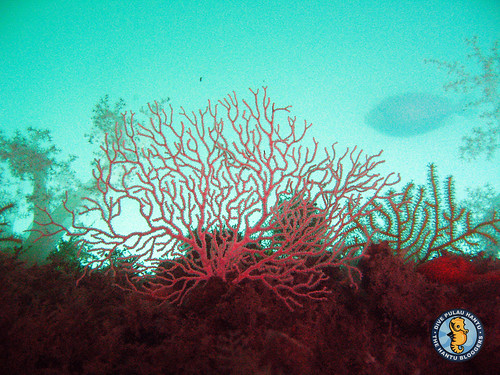
Sea fans growing on pontoon at Keppel Marina;
(Photo by Debby)

Coral reef along seawall at Tanah Merah;
(Photo by Kok Sheng)
These examples show how marine life is able to naturally colonise any suitable surface, without any additional expenses involved. One does not need to undertake expensive projects to get corals growing; the basic ingredients are a stable substrate, relatively clean waters, a possible source of larvae, and time. As long as there isn't any disturbance or development, or pollution such as an oil spill, organisms will eventually settle and grow. Yes, artificial reefs can play a part in marine conservation, but here in Singapore, the key area of focus is protecting our natural reefs from development.
A final point is about the importance of blogging. Many people continue to dismiss blogs as mere online diaries, or denigrate people who create and share content via social media as being attention-seeking. Yet I feel that a blog focused on a particular topic can go a long way towards outreach and education efforts. There are a number of excellent blogs written by fellow people residing in Singapore, sharing with people all over the world about our rich biodiversity and the threats that we face. It was through Ria's blog that the seacil project came under scrutiny by many others, not just nature lovers, but also by the general public.
A blog devoted to a single project, even if it's not meant to be a long-term effort, can help to publicise the project's aims and provide a personable place to engage the masses. Just look at the blogs created for programmes such as Team Seagrass, or the Mega Marine Survey of Singapore. With frequent updates, the general public not only gets an insider's view of the project's progress, but are also able to use it as a springboard to find out more information and learn about the topic in general, as well as providing an avenue for discussion and dialogue.


Note this post written in late 2007, which cited another blog post revealing that the people behind the seacil project apparently did not wish to engage the critics. As a result, this left a lot of points of inquiry which were not clarified or clearly answered.
If a blog is too labour-intensive, at the very least, a talk open to members of the public is another platform to engage and educate. I have learnt a lot by attending presentations of projects carried out on various aspects of biodiversity, whether it's on giant clams, mammals and freshwater crabs of Singapore, seed dispersal in rainforests, or sea anemones. Attendance might not always justify the time and effort put in for preparation, but at least, no one can fault you for not providing a proper platform for communication and discussion.
Conclusion
I commend Charles Rowe for his single-minded dedication to his project, and for having the courage to stand in front of an audience and present his ideas and justifications, after coming under fire from the very same people in the past. I salute his devotion and sacrifice, and for the attention he has continued to pay to the seacils, making diving trips to check on the progress of the coral growth. While there have been disagreements about whether the collateral damage is justified, I feel that in the end, we all harbour the same hope of being able to restore some of the damage that our seas have suffered as a consequence of Singapore's growth and development.
On the other hand, Singapore Polytechnic did not send any representatives, nor have they come forward to offer their side of the story. This is especially disconcerting, since this project was fronted by representatives from Singapore Polytechnic. After all the publicity, are they still involved? Or has it been abandoned, leaving Charles Rowe with the unenviable task of being the sole person carrying out damage control?
Ultimately, I think that this whole saga of the seacil stands as an example of what can go wrong if projects are carried out without sufficient consultation and engagement of the local conservation community. No proposal, no matter how visionary, can succeed in the long term without the solid support of others. Even seemingly sound ideas can be subject to flaws which only an outsider may be able to point out, and there will be times when expertise and assistance from more experienced individuals are required to ensure that the project's objectives are met. Without hard data to show the net benefits, or large numbers of people committed in the long term, such schemes run the risk of turning into vanity projects with very little genuine conservation value.
My general feeling is that the seacil project could have achieved much, while avoiding a lot of the ire and unhappiness over the last few years, if only this discussion had taken place much earlier, such as before work actually commenced at Labrador, or when we had first enquired about the seacils on the shore. If details had been ironed out and we had a clearer picture right from the start, then we could have provided a lot more contributions in terms of devising better protocols for construction and monitoring, strengthening the scientific rigour of the project, and even lending a helping hand in manpower, logistics, and raising awareness.
I don't celebrate the fact that the seacil project has apparently drawn to a close. Rather, I lament that this was a project with much potential that floundered because people with the knowledge and experience in handling local conservation projects were not involved or engaged, there was a lack of open dialogue with other stakeholders, and bad public relations strategies in general.
In the end, it's not about who is right or who is wrong, but what's the best course of action for the health of the marine ecosystems at Labrador. Let's just hope that when the construction work dies down, the water will clear up, and the seas will recover their former glory. The seacils may or may not help to enhance the overall recovery of coral growth at Labrador, but at the very least, I hope they produce positive results.
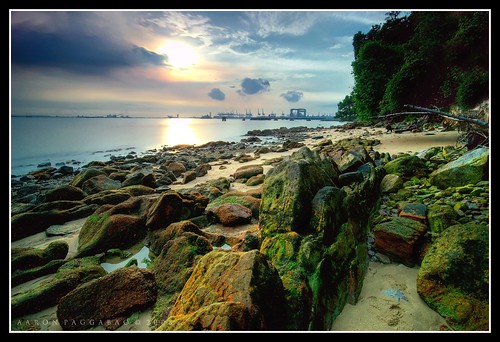
(Photo by [Spumpie])